3 Chapter 6 UUV Integrated Autonomous Missions & Drone Management [Mumm]
Student Learning Objectives
The student will gain knowledge of the concepts and framework as it relates to the unmanned underwater vehicle (UUV) missions, including military and civilian uses for surveillance and reconnaissance, research, as well as offensive and defensive employment of such technology. The student will be able to:
- Understand the historical nature of underwater missions and why UUVs are becoming more important to the military and industrial arena.
- Discuss the differences in manned versus unmanned underwater vehicle deployment.
- Analyze and differentiate missions that are best suited for UUV missions and which missions might be best served by manned submarines.
- Explore the ever-increasing list of sensors and mission packages available for UUVs, which allow UUV deployment envelopes to expand and occupy more of the underwater marketplace.
History-What is it, and Why Does it Matter?
This chapter explores the differences and similarities of how manned and unmanned underwater vehicle technology is employed for different mission sets and some of the challenges the industry faces as UUVs become the norm, and manned submarines become more focused on specialized missions, as well as tasking and integrating UUVs into existing manned architecture. UUVs come in all shapes and sizes, starting from about a meter in length going up to what is now known as an “Extra Large Unmanned Undersea Vehicle” (XLUUV). The wide variety of sizes and shapes of UUVs offers mission flexibility in an arena that is at its infancy stage.
The mysteries of the seas fascinate humankind. The vastness of the seas with all of its wonders spawned ancient Greek religion to believe in Poseidon; known as the “king of the seas…lord of the sea-gods, as he dwelt in a golden palace on the sea bed with his queen Amphitrite and son Triton” (Sea Gods, 2017). For centuries sailors prayed to “Amphitrite, goddess who spawned the sea’s rich bounty–fish and shellfish–as well as dolphins, seals, and whales” (Sea Gods, 2017). Sailors also prayed to these deities for a safe journey and a bountiful catch. Humankind’s desire to learn, conquer, and use the sea for its betterment creates the need for technologies and techniques to allow humans to obtain their goals.
As early as 1578, an “English mathematician and royal navy gunner published a book that described his idea for engineering a submarine” (Joanne, 2019). In 1620 the first working submarine known as the Drebbel was invented by Cornelis Drebbel and was propelled by oars that were under the vehicle. By “1623, Drebbel’s watercraft carried 16 passengers under the River Thames in London…staying underwater for about three hours” (Joanne, 2019). Forty years later, the first submarine with an engine was created known as the Diver. This submarine engine used compressed air. The air was forced from a tank into a cylinder, and this air movement pushed a piston that turned the propeller. John Philip Holland improved the design and “engineered a submarine that used battery power…batteries created electricity-powered a motor to turn the propeller” (Joanne, 2019).
Submarine inventors took great risks even with their own lives as they worked to perfect the ability to survive underwater for longer time frames. In 1850 “Wilhelm Bauer built his first submarine… but only narrowly escaped with his life after it sank in 50 feet of water during a demonstration” (Andrews, 2018).Wilhelm Bauer would be undeterred by this setback as he received financial backing from the Russian government and went on construct the “Sea Devil.” The Sea Devil made more than one hundred and thirty successful dives and “boasted several technological breakthroughs including multiple ballast tanks for added buoyancy, a crude airlock and a propeller that was powered by crewmen operating an internal treadmill” (Andrews, 2018).
Early American Submarine Usage
For almost two hundred and fifty years, submarines have been used as a wartime vessel. The first attempt to use submarines as an attack vessel was during the American Revolutionary War; and on “September 6, 1776, an American named Sergeant Lee tried to attack a British ship using the Turtle. Lee drilled a hole in the ship, but he ran out of air before he could attach the mine” (Joanne, 2019). In 1863, a privately funded venture in Mobile, Alabama, using a recycled iron steam boiler ushered in the first successful primitive attack submarine known as the H.L. Hunley. This attack submarine offered new naval tactics to be introduced during the US Civil War. Breaking the stronghold of the Union naval blockades allowed the Confederacy to move supplies and keep the Union naval ships at risk. The Hunley was known as the “peripatetic coffin”—and for good reason. It sank on two occasions during its trial runs, killing a total of 13 crewmen including its namesake, marine engineer Horace Lawson Hunley” (Andrews, 2018).
Commissioned on October 12, 1900, the USS Holland became the first US Navy submarine. Although the USS Holland was never employed in combat, “The ship’s armaments consisted of a single torpedo tube and pneumatic cannon known as a “dynamite gun.” It was powered by a 4-cylinder gasoline engine for surface travel, but also included a 160-horsepower electric motor to move underwater” (Andrews, 2018).
World War I saw the introduction of the German U-boats, better known as “undersea boats.” Built on production lines to allow for economies of scale and training of its crew, the U-boats were introduced into the German fleet to attack enemy military ships. Later, the U-boats were used to “attack merchant ships and passenger liners. In just one day in September 1914, a German U-boat sank three British ships. Between February and April 1917, U-boats sank more than 500 merchant ships” (Joanne, 2019).
New technologies such as sonar and radar allowed submarines to take an important leap forward in their importance in contributing to military successes. Submarines became a key component to WWII as “Nazi Germany and Imperial Japan were major sea powers during World War II by adding submarines to their surface fleets. That combination remains the key to sea power today” (Wilson, 2019)
Submarines were used in the Gulf War (1990-1991) to launch land-attack missiles, and submarines are currently used in the ongoing War on Terror. The ability to be stealth and persistent allows mission planners flexibility in employment, and UUVs will broaden this flexibility envelope in future years.
Submarines and UUVs continue to illustrate their importance to the world although “it is only in the last thirty years that progress in propulsion; control, hydrodynamics, and sensor technology have enabled the development of more broadly capable vehicles and free the imaginations of naval planner to propose new and innovative operational applications for them” (Whitman, 2002).
The ability to remove the human from a submarine and allow the vehicle to be remotely operated by wire and later fully autonomously is still in a formative stage, as illustrated in Table 1; however, the capability increase is being heavily funded and is moving quickly to the forefront of the UUV arena.
Table 6.1: The Evolution of UUVs and Their Capabilities
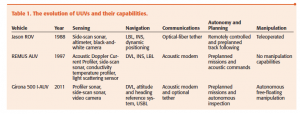
Source: (Petillot, 2019)
In the modern-day US Navy, it has taken nearly three decades of development and experimentation in the unmanned systems arena; however, “unmanned underwater vehicles are close to joining the fleet in meaningful numbers and substantive roles…UUVs are rapidly gathering momentum and critical mass of supporters” (Whitman, 2002).
Submarine and UUV Current Military Missions
The primary roles and missions for the U.S. submarine force are peacetime engagement, surveillance and intelligence, special operations, precision strike, battlegroup operations, and sea denial using naval or port blockades.
Keeping in mind that in the current global security environment, naval forces have an ideal disruptive technology in UUVs that offers “many challenges both in the form of asymmetric threats and confrontations between peers” (Newswire, 2018) while allowing human assets to stay out of harm’s way. UUVs will have “initial emphasis on minefield reconnaissance, intelligence collection, trailing, tagging, deception, and attack capabilities are potential future options” (Whitman, 2002). These UUV capabilities will include a range of command and control options including creating an optionally piloted submarine with the on the fly ability to transition to near-total autonomy or full autonomy.
The US Navy published The Navy Unmanned Undersea Vehicle (UUV) Master Plan in 2004 and then updated the plan in a February 18, 2016, Congressional report “using Sea Power 21 for guidance, nine Sub-Pillar capabilities were identified and prioritized:
- Intelligence, Surveillance, and Reconnaissance
- Mine Countermeasures
- Anti-Submarine Warfare
- Inspection / Identification
- Oceanography
- Communication / Navigation Network Node
- Payload Delivery
- Information Operations
- Time Critical Strike” (The Navy Unmanned Undersea Vehicle (UUV) . See Figure 6.1, US Navy UUV Systems Vision.
The UUV Master Plan identifies four basic signature capabilities and provides an outline for the development of the underlying technologies required to implement these signature capabilities for littoral operations. The signature capabilities include:
- Maritime Reconnaissance (MR) – centers on the Intelligence, Surveillance, Reconnaissance (ISR) functions, target designation; launch and coordination of UUVs for battle damage assessment; and intelligence collection.
Undersea Search and Survey (USS) – provides the ability to rapidly survey selected areas through the use of networks of small UUVs, performing functions
- such as mine hunting/neutralization, underwater object location and recovery, and hydrographic/bathymetric surveys.
- Communication/Navigation Aid (C/NA) – provides a communication/navigation relay for other underwater vehicles operating within the immediate area and is expected to serve as a gateway for an autonomous underwater communication/navigation network.
- Submarine Track and Trail (ST&T) – provides a mobile cueing function, but could grow into a fully autonomous system offering multiple levels of engagement (Wenli, 2000).
Figure 6.1: US Navy UUV Systems Vision
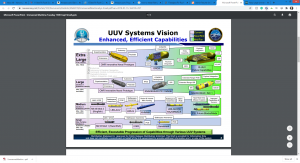
Source: (Clark, 2020)
Anti-submarine warfare (ASW) is a difficult mission the Navy must perform, and this is a good reason why the Navy should increase the use of UUVs in the performance of ASW. Although sonars are used to detect submarines; sonars have only a “fraction of the range and precision possible using radars or visual sensors against ships above the water. Unmanned aircraft could deploy sonobuoys or stationary sonar arrays, and unmanned undersea or surface vehicles could tow passive sonar arrays” (Clark, 2020). The integration of UUVs with unmanned surface vehicles would allow the deployment of “low-frequency active sonars like those carried by U.S. undersea surveillance ships that can detect or drive off submarines from dozens of miles away” (Clark, 2020).
In a March 9, 2020 article by Lyle Goldstein titled “New UUSs: China’s plan to ‘attack from the seafloor,” Mr. Goldstein explains, “The robot submarine (and unmanned surface ship) era is now nearly upon us. Chinese naval strategists have stated explicitly that they intend to circumvent their long-recognized weakness in submarine warfare by cultivating undersea AI and by developing highly capable UUVs” (Goldstein, 2020).
In an August 2019 article published by Military & Aerospace Electronics it was disclosed that
In 2018, China announced it was working on an AI-run underwater base, equipped with autonomous submarines to extend its reach. According to published reports, the submarines would deploy for investigation and scientific surveillance missions, then return to the unmanned base to download data and recharge. The base itself, located on the ocean floor as deep as 36,000 feet, also would conduct research on the immediate area, process and fuse all collected data, and transmit the results to a surface ship or land station (Wilson, 2019).
The Chinese government is also conducting an interesting counter tactic to UUVs as “the secretive world of naval underwater surveys rarely breaks the surface” (Sutton, 2020). The Chinese government rewards its fishing industry when vessels are able to capture (or report on) foreign UUVs operating near its coast (international waters). “China has been holding the annual awards ceremonies since 2016. This year 11 (2020), fishermen were rewarded for handing over unidentified underwater vehicles which they had found” (Sutton, 2020).
Submarine and UUV Civilian/Academic Missions
The academic and environmental research communities are steadily increasing their use of UUVs as “interest in using UUVs in private industry is growing simultaneously, and internationally, at least half-dozen firms have begun to commercialize UUV technology developed in university and military laboratories” (Whitman, 2002). Although oceans cover most of our planet, humankind’s knowledge of its mysteries appears to be small in scale as “only a fraction of these vast waters has been explored, and much of the underwater world is little understood” (Loria, 2016). The Aquarius Reef Base is currently the only permanent underwater research laboratory in the world. It is operated by Florida International University in cooperation with NASA, the US Navy, and other research facilities around the world.
Poised for rapid growth, the list of commercial uses of UUVs continues to increase. Some of these commercial and civilian missions for UUVs include underwater tourism, logistical movement of goods, infrastructure monitoring of bridges, oil pipelines, underwater sea cables, undersea mining, and bottom mapping. Additional missions are being explored, such as law enforcement applications, long term monitoring of environmental issues, and sea traffic management in shipping lanes.
As Mr. Stockton Rush explained in an April 17, 2017, Popular Science Magazine article titled “Deep Sea Tourism Could Become a Thing”, Humankind has explored only about five percent of the ocean, and the federal government isn’t doing much to improve that… There’s a huge demand for travel that’s different,” he says. “People want to do something meaningful” (Fecht, 2017).
UUV technology, along with most submarine technology is commercially available and sometimes can be used in unintended applications such as human trafficking or illegal drug smuggling. In November 2019, Spanish authorities captured a drug-smuggling submarine and indicated that “This new attempt to use the narco submarine to bring drugs into Europe in the first place is a much more ambitious undertaking and appears to have largely succeeded on a general technical level” (Trevithick, 2019). In 2010 a drug smuggler was found in Africa building a $20 million submarine to smuggle illegal drugs to the United States. As UUV technology becomes more reliable and affordable, illegal uses are sure to increase as illustrated by international drug smugglers “it is a clear indication that the use of narco subs in those activities may be an increasingly viable tactic” (Trevithick, 2019).
UUV Markets
The majority of the Earth’s surface is covered by water, and approximately “40% of the population living near coastlines, with many energy resources found in the sea and with shipping being the arteries of global commerce” (Newswire, 2018). the potential for UUV manufacturing, parts, service, research and development, and future uses is almost limitless.
Although the larger markets for UUVs is clearly the defense sector, the private sector use will drive profitability of the manufacturing and services support channels. Several mission enhancements will boost these markets “in the fields of autonomy, batteries and power management, underwater telecommunications, underwater charging, sensors, and most importantly in Artificial Intelligence” (Newswire, 2018). The UUV markets are poised for rapid expansion and growth. In 2018, the international market value was estimated to be worth US $9.4 billion. This estimate was based on growing requirements, availability, manufacturing and other industrial indicators (Newswire, 2018).
Senior officials have a stated goal of pursuing a 355-plus-ship fleet of manned vessels, but unmanned systems are “probably the future of the Navy,” according to Robert Levinson, a senior defense analyst at Bloomberg Government, during a recent webinar.
It is estimated that about $7.9 billion in the future year’s defense program would support drones…An additional $2.2 billion would be allocated toward unmanned surface vessels, or USVs, and $1.9 billion for unmanned underwater vessels, or UUVs. Navy plans call for spending $941 million on USVs and UUVs in 2021 alone, a 129 percent increase over 2019 spending allocations (Harper, 2020).
Unmanned vessels are generally expected to be less expensive to procure, operate, and maintain than manned platforms, which make them attractive as the sea service invests in new capabilities (Harper, 2020).
The world’s economy and its’ ability to fund research and development to expand markets and encourage innovations such as UUV underwater tourism, UUV transportation of goods and passengers, and undersea UUV bases will have a deciding impact on the speed and overall success of the UUV industry. This global UUV market is heavily influenced by political turmoil as the importance of the seas cannot be understated. The South China Sea is a good example where “Amid the growing push for decoupling and economic distancing, the changing relationship between China and the rest of the world will influence competition and opportunities in the Unmanned Underwater Vehicles (UUV) market” (Research, 2020).
Teaming UUV with Manned Equipment
As UUVs become more capable and societies continue to seek “bloodless wars,” the militaries of the world will work to integrate “unmanned underwater vehicles (UUVs) as adjuncts to conventional manned platforms in many of the submarine missions that arise in expeditionary warfare” (Whitman, 2002). This transition will start slowly with simple minefield reconnaissance, intelligence collection, and deception mission; however, as confidence in the UUV rises, “attack capabilities are potential future options, with command modalities that range from simple remote control to near-total autonomy” (Whitman, 2002).
Optionally piloted UUVs will allow the expansion of manned and unmanned teaming and will bring it into the normative technologies for military and civilian missions alike. This teaming arrangement will only work if the manned operator can understand and trust what the unmanned systems actions are or will be during the missions. Pre-planned missions will be the start of this relationship, however as AI is introduced and the need for mission deviation and flexibility is required, pre-planned mission execution will give way to AI goal seeking with extended mission capabilities. These extended capabilities and teaming opportunities are being explored as a “detection method for submarine oil pipeline leakage under complex sea conditions by UUVs… the usual practice is to check whether there is oil spill on the sea surface by chartering ships to patrol the line regularly or in the event of leakage accidents” (Zhao, 2019).
Navy special forces conduct missions that require shallow-water reconnaissance in support of amphibious landings and other intelligence-gathering activities. The Navy is looking to pair manned and unmanned systems for this type of an operation, and “small UUV denoted the Semi-Autonomous Hydrographic Reconnaissance Vehicle (SAHRV) has been identified as a leading solution” (Whitman, 2002).
The Naval Undersea Warfare Center is working on concepts that would allow teaming to occur in a seamless way including have “several very large, flatfish-shaped UUVs mated externally to a “mother” submarine could provide a powerful and flexible adjunct to the combat power of their host in off-board operations” (Whitman, 2002) as seen here in Figures 6.2 and 6.3.
Figures 6.2 and 6.3 demonstrate the Notional MANTA concept developed by the Naval Undersea Warfare Center that MANTA vehicles could carry significant payloads of sensors and heavyweight weapons (Whitman, 2002).
Figure 6.2: Notional Manta Concept
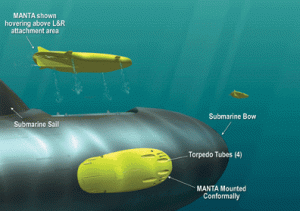
Source: (Whitman, 2002)
Figure 6.3: Notional Manta Layout Capabilities
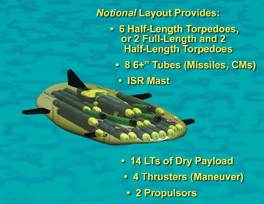
Sources: (Whitman, 2002)
AI and its Influence in the Future of the Integrated Architecture of UUVs
Advances in sensor systems, hull materials, propulsion technologies, and data science will drive the UUV missions to places that have not even been considered at the moment. These technologies will include all the subsystem level technology developments allow for the increase in “survivability and adaptive control of vehicles in complex/dynamic/tactical environments; reduce communication and human supervision requirements; enable cooperative, multi-vehicle operations with navigation aids and communication relays; and provide increased levels of situational awareness” (Wenli, 2000).Specific areas of interest in autonomy include:
- Planning and control architectures
- Path planning (including obstacle and dynamic threat avoidance, adaptive route planning)
- Behavior development
- Mission planning/re-planning
- Multiple vehicle behavior and control
- Multiple vehicle imaging, localization, and data fusion
- On-board mapping of environmental variability, identified objects and moving contacts
- Effective man-machine interface with a limited communication capability.
(Wenli, 2000)
The traditional navigation pattern is depicted in Figure 6.4, however, this scheme is limited, and it is being improved upon through the use of a communication bridge which “allows vehicles to send information from a distant operating area back to a remote operator” (Lockheed Martin, 2017) as seen in Figure 6.5.
Figure 6.4: The scheme of a navigation, guidance, and control architecture for a UUV
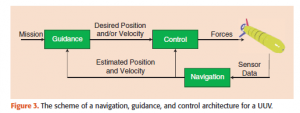
Source: (Petillot et al., 2019)
Figure 6.5: Depiction of an Undersea Communication Bridge
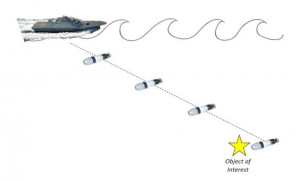
Source: (Lockheed Martin, 2017)
Figure 6.5 displays the ability for UUVs to autonomously create a communication bridge in order to relay data back to the host ship (Unmanned Underwater Vehicle Collaborative Missions A Decentralized Approach to Operating UUV Teams, 2017).
The underwater environment is not conducive to real-time command and control, and this communication limitation makes some form of AI use mandatory. UUVs are driving pioneering research in artificial intelligence, unmanned swarming technology, navigation, and underwater communications. The U.S. Navy is seeking additional AI capabilities, especially undersea:
“As the current submarine force trusts mechanical and electrical technology to execute the mission, the future force will need to trust AI to extract and exploit actionable patterns among an ocean of data,” the session says. “The advent of big data and deep learning technology has rendered signal detection and classification an increasingly automated process. Furthermore, advances in autonomous navigation have enabled unmanned platforms to operate alone or in swarms (Wilson, 2019).
Extending trust to AI systems is one of the goals of the DARPA’s Explainable Question Answering System (EQUAS) Project. The EQUAS Project will show users which data mattered most in AI decision-making, and it was created “to build trust, we have to give the user enough information about how the recommendation was made, so they feel comfortable acting on the system’s recommendation” (Wilson, 2019). The idea is that “We know why humans may mess up a decision; there’s no intuitive way to know when machines are wrong,” says Bill Ferguson, lead scientist at Raytheon BBN Technologies” (Wilson, 2019).
DARPA is also working on the “Ocean of Things” Project that will analyze information from thousands of float sensors in the ocean. This project is targeting towards “affordable ocean sensing at large scales and high resolution, the project’s analytics portion seeks to provide detailed understanding of the ocean environment to protect natural resources and enable the military to operate more effectively on the high seas” (Keller, 2020). This information can then be used to train UUV AI systems and allow for as close to real-time updates as technically available in the oceanic environment. Continuous information updates from the Ocean of Things Project can move the UUV arena towards full autonomy with the ability of on the fly mission deviations and re-tasking of the UUVs as required as “only speed, endurance, and the adequacy of onboard autonomous control and decision-making will limit what UUVs can do” (Whitman, 2002). The Ocean of Things can build capabilities that can become key to UUVs “because today’s naval and commercial ships typically can use only their onboard sensors for situational awareness” (Keller, 2020).
The future missions of UUVs is discussed at length at the U.S. Post Naval Graduate School and it was the subject of a 2013 paper titled “2024 Unmanned Undersea Warfare Concept”. Coupling AI into this concept would allow UUVs to “remain one of the top priorities of the Chief of Naval Operations, as UUVs serve as effective force multipliers, while greatly reducing
risk, in critical missions in A2AD environments” (Blandin, 2013) as illustrated in Figure 6.6.
Figure 6.6: 2024 UUV Concept of Operations
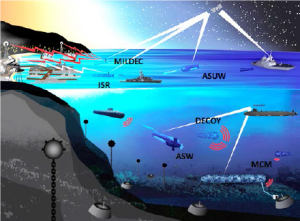
Source: (Blandin, 2013)
Figure 6.6 illustrates what undersea warfare might look like in FY2024 and how forward operating UUVs would autonomously function in hostile A2AD environments with multi-layered enemy defenses including submarines, aircraft, ASCMs, ASBMs, and mines. (Blandin, 2013).
The scalability of future missions and full integration of UUVs into an operating architecture will require a several technologies to mature at once and work in concert with each other for the mutual success of all involved systems. AI is the component that will sew all of these technologies together and allow UUVs to reach their full potential in the shortest amount of time. The security of these systems, along with the laws, policies, and worldwide agreed-upon governance of UUVs, is work that has barely even begun to be tackled, and a much more concerted effort is required to move forward on these fronts.
Personnel/Human Implications
The human aspect of UUVs should not be overlooked as the training and re-training of personnel will affect the overall readiness of seaborne operations. While this chapter is not focused on this issue, it is an issue that must be factored into the current and future mission planning cycles and technology refresh cycles for seaborne operations, including UUVs. The psychological effects of turning over a traditional manned mission to a robot and allowing that robot at times to operate with more autonomy than allowed by manned systems can create distrust and resentment within the workforce. A March 30, 2020, Congressional Research Service report offered the following:
Another oversight issue for Congress concerns the potential personnel implications of incorporating a significant number of large UVs into the Navy’s fleet architecture. Potential questions for Congress include the following:
- What implications might these large UVs have for the required skills, training, and career paths of Navy personnel?
- Within the Navy, what will be the relationship between personnel who crew manned ships and those who operate these large UVs? (O’Rourke, 2020)
Additional thought must be given to issues such as liability boundaries, acceptable losses of UUVs when the traditional calculation is acceptable human losses. Environmental, economic, and economic disparity must be considered in the personnel/human implication of UUV missions and mission expansion.
Conclusions
The UUV arena is still very much in its infancy stages. The ability to transverse over, on top of, and under the vastness of the oceans offers humankind learning opportunities that are boundless. As the strategic importance of the world’s oceans continues to grow, so will the desire to understand, control, and harness this importance.
The military aspects of UUVs are driven by the ability to use the technology to carry out dull, dirty, and dangerous missions without putting human operators in danger. The missions assigned to UUV will grow exponentially as trust in the systems becomes as commonplace as using a smartphone.
The advent of UUV underwater basing operations and the use of AI in UUVs will usher in a new era in manned/unmanned and optionally piloted submarines missions and uses for military, commercial and academic research. The ability to team with these systems with other manned platforms at sea as well as air and land assets are already accounted for in future integration architectures. As UUVs and all unmanned systems become trusted agents, their utility, as seen in Figure 6.7, is almost limitless; the issue will become one of laws, regulations, policies, and how different countries deploy such technology against each other.
Figure 6.7: Teledyne Technologies portfolio of undersea products, capabilities, and systems

Source: (Teledyne, 2018)
UUV missions are only beginning to be discovered, the advent of underwater tourism, commercial shipping, commercial transportation, and the academic support of UUVs all will keep pace if not rival the missions assigned to UUVs by the world’s militaries.
Questions
- List four advantages and disadvantages of using an autonomous UUV and a manned submarine.
- What are some of the integration challenges facing UUVs as they integrate into the world’s military arena?
- For surveillance and reconnaissance, does the UUV size and composition matter? Why or why not?
- How would you position multiple sensors to surveil a given area with a UUV?
- Would you consider a UUV a military instrument or a civilian research tool?
References
Andrews, E. (2018). 9 Groundbreaking Early Submarines. Retrieved from /www.history.com/: https://www.history.com/news/9-groundbreaking-early-submarines
Blandin, M. B. (2013). 2024 Unmanned undersea warfare concept – Naval Postgraduate School. Retrieved from calhoun.nps.edu/handle/10945/34733.: https://calhoun.nps.edu/handle/10945/34733.
Clark, B. (2020). US Navy Should Turn to Unmanned Systems to Track and Destroy Submarines. Retrieved from Defense News. .
Fecht, S. (2017). Deep sea tourism could become a thing soon. Retrieved from Popular Science.
Goldstein, L. (2020). New UUVs: China’s Plan to ‘Attack from the Sea Floor’. Retrieved from The National Interest.
Harper, J. (2020). Navy Wants $12 Billion for Unmanned Platforms. Retrieved from National Defense. .
Joanne, M. (2019). Engineering Wonders Submarines and Submersibles. Retrieved from Vero Beach: Rourke Educational Media.
Keller, J. (2020). Analyzing data from thousands of floating sensors is goal in second phase of DARPA Ocean of Things project. Retrieved from Military & Aerospace Electronics. .
Lockheed Martin. (2017). Unmanned Underwater Vehicle Collaborative Missions A Decentralized Approach to Operating UUV Teams. Retrieved from lockheedmartin.com: https://lockheedmartin.com/content/dam/lockheed-martin/eo/documents/webt/Unmanned-Underwater-Vehicle-Collaborative-Missions.pdf
Loria, K. (2016). What it’s like inside the only permanent undersea research lab in the world. Retrieved from Business Insider.
Navy, U. (2004). The Navy Unmanned Undersea Vehicle (UUV) Master Plan- Washington DC: Department of the Navy. Retrieved from www.navy.mil/navydata/technology/uuvmp: https://www.navy.mil/navydata/technology/uuvmp.pdf.
Newswire, P. R. (2018). Market Forecast provides a detailed analysis of the military Unmanned Underwater Vehicles (UUV) market in the years 2018 through to 2025. In UUV-Military. Retrieved from In UUV-Military: Y.
O’Rourke, R. (2020). Navy Large Unmanned Surface and Undersea Vehicles: Background and Issues for Congress. Retrieved from fas.org/sgp/crs/weapons/R45757: https://fas.org/sgp/crs/weapons/R45757.pdf.
Petillot, Y. R. (2019). Underwater Robots: From Remotely Operated Vehicles to Intervention-Autonomous Underwater Vehicles. IEEE Robotics & Automation Magazine, 26(2), 94. IEEE Robotics & Automation Magazine, pp. 26(2), 94. Retrieved from Petillot, Y. R., Antonelli, G., Casalino, G., & Ferreira, F. (2019). Underwater Robots: From Remotely Operated Vehicles to Intervention-Autonomous Underwater Vehicles. IEEE Robotics & Automation Magazine, 26(2), 94. : Petillot, Y. R., Antonelli, G., Casalino, G., & Ferreira, F. (2019). Underwater Robots: From Remotely Operated Vehicles to Intervention-Autonomous Underwater Vehicles. IEEE Robotics & Automation Magazine, 26(2), 94.
Research, &. M. (2020). Unmanned Underwater Vehicles (UUV) Market Outlook to 2027 Including the Impact of COVID-19 on the Industry . Retrieved from ResearchAndMarkets.com. In.
Sea Gods. (2017). Retrieved from www.theoi.com/greek-mythology/sea-gods.html: https://www.theoi.com/greek-mythology/sea-gods.html
Sutton, H. (2020). China Discovers Underwater Spy Drones In Its Waters. Retrieved from www.forbes.com: https://www.forbes.com/sites/hisutton/2020/01/15/china-discovers-underwater-spy-drones-in-its-waters/#34a3453c6990
Teledyne. (2018). Teledyne Brown Engineering Awarded Next Generation UUV Contract Vehicle. Retrieved from tbe.com/news_and_events/press_release_view/teledyne-brown-engineering-awarded-next-generation-uuv-contract-vehicle: https://tbe.com/news_and_events/press_release_view/teledyne-brown-engineering-awarded-next-generation-uuv-contract-vehicle
Trevithick, J. (2019). The First Narco Submarine Ever Seized Off A European Coast Is A Monster. Retrieved from www.thedrive.com/the-war-zone/: https://www.thedrive.com/the-war-zone/31248/the-first-narco-submarine-ever-seized-off-a-european-coast-is-a-monster
Wenli, R. L. (2000). Low Cost UUV’s for Military Applications: Is the Technology Ready? Retrieved from Washington DC: Defense Technical Information Center: https://apps.dtic.mil/sti/citations/ADA422138.
Whitman, E. C. (2002). Unmanned Underwater Vehicles: Beneath the Wave of the Future. Retrieved from www.public.navy.mil/subfor/underseawarfaremagazine/Issues/Archives/issue_15/: https://www.public.navy.mil/subfor/underseawarfaremagazine/Issues/Archives/issue_15/wave.html
Wilson, J. R. (2019). Unmanned submarines seen as key to dominating the world’s oceans: Unmanned underwater vehicles (UUVs) are driving pioneering research in artificial intelligence (AI) underwater communications, autonomous navigation, and unmanned swarms. Military & Aerospace Electronics, pp. 30(8), 10-19. . Retrieved from Military & Aerospace Electronics, 30(8), 10-19. .
Zhao, H. &. (2019). Detection Method for Submarine Oil Pipeline Leakage under Complex Sea Conditions by Unmanned Underwater Vehicle. Journal of Coastal Research, 97, 122-130. doi:10.2112/SI97-017.1.

